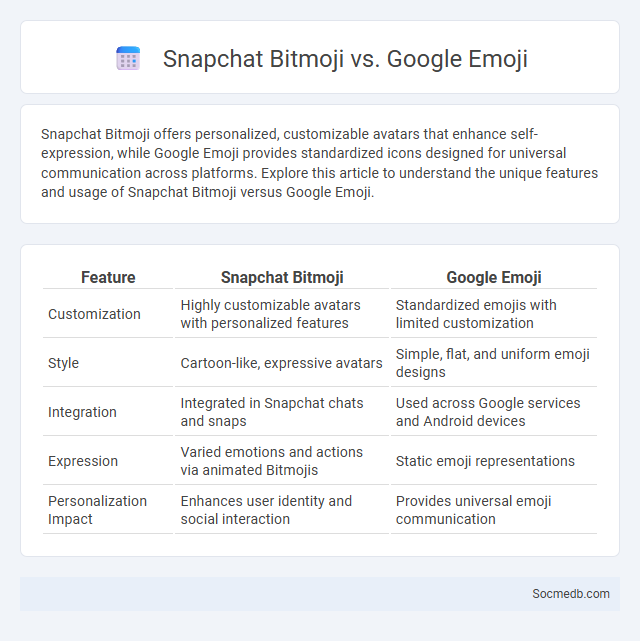
Photo illustration: Snapchat Bitmoji vs Google Emoji
Snapchat Bitmoji offers personalized, customizable avatars that enhance self-expression, while Google Emoji provides standardized icons designed for universal communication across platforms. Explore this article to understand the unique features and usage of Snapchat Bitmoji versus Google Emoji.
Table of Comparison
| Feature | Snapchat Bitmoji | Google Emoji |
|---|---|---|
| Customization | Highly customizable avatars with personalized features | Standardized emojis with limited customization |
| Style | Cartoon-like, expressive avatars | Simple, flat, and uniform emoji designs |
| Integration | Integrated in Snapchat chats and snaps | Used across Google services and Android devices |
| Expression | Varied emotions and actions via animated Bitmojis | Static emoji representations |
| Personalization Impact | Enhances user identity and social interaction | Provides universal emoji communication |
Introduction to Personalized Digital Avatars
Personalized digital avatars revolutionize social media by allowing users to create unique, customizable virtual representations that enhance online identity and engagement. These avatars leverage advanced AI and graphic design technologies to mirror user traits, emotions, and styles, enriching interaction across platforms like Instagram, TikTok, and Snapchat. By enabling authentic self-expression and immersive communication, personalized digital avatars drive more meaningful connections and elevate overall social media experiences.
Overview of Snapchat Bitmoji
Snapchat Bitmoji is a personalized cartoon avatar that users can create and customize to represent themselves within the Snapchat platform. Integrating seamlessly with Snapchat's messaging and Stories features, Bitmojis enhance user interaction and self-expression by adding a unique, visual element to chats and snaps. The feature leverages user data to offer diverse customization options, reflecting current trends in digital identity and social media engagement.
Features and Customization in Google Emoji
Google Emoji offers a wide range of features that enhance user interaction, including extensive facial expressions, diverse skin tones, and gender variations to ensure inclusivity. Customization options allow users to select emojis that reflect their identity and emotions accurately, improving communication clarity on Google platforms such as Android and Gmail. These emojis are regularly updated to align with Unicode standards, maintaining consistency and relevance in digital conversations.
What Makes Bitmoji Unique?
Bitmoji stands out by offering personalized cartoon avatars that users can customize extensively to reflect their unique appearance and style. Its seamless integration with Snapchat enhances social interaction by allowing users to express emotions and reactions with highly relatable and context-specific stickers. The platform's use of AI-driven customization and continuous expansion of expressive options makes Bitmoji a distinctive tool for personalized digital communication.
Design Differences: Bitmoji vs Google Emoji
Bitmoji offers highly customizable avatars that reflect your personal style through unique facial features, clothing, and accessories, creating a more individualized social media experience. Google Emoji relies on standardized, universally recognizable symbols designed for consistency across platforms, prioritizing clarity and simplicity. Your choice between these designs impacts how you express emotions and identity in digital communication.
Integration with Social Media Platforms
Seamless integration with social media platforms enhances your brand's online visibility by allowing real-time content sharing and engagement analytics. Leveraging APIs from Facebook, Instagram, Twitter, and LinkedIn enables automated posting and tailored user interactions. You can optimize marketing strategies with comprehensive data insights and cross-platform campaign management, driving higher audience reach and engagement rates.
User Experience and Accessibility
Optimizing social media platforms for user experience ensures seamless navigation, faster load times, and intuitive interfaces that engage Your audience effectively. Integrating accessibility features such as screen reader compatibility, captioned videos, and keyboard-friendly controls broadens inclusivity for users with disabilities. These enhancements not only improve satisfaction but also increase overall reach and social interaction.
Popularity and User Base Comparison
Social media platforms like Facebook, Instagram, and TikTok dominate in popularity with billions of active users worldwide, reflecting significant engagement and content diversity. Facebook boasts over 2.9 billion monthly active users, making it the largest platform, while Instagram attracts around 2 billion users, favoring visual content sharing. TikTok's rapid growth to over 1 billion monthly active users highlights its appeal among younger demographics, emphasizing short-form video content.
Security and Privacy Considerations
Protecting your personal information on social media platforms requires strong passwords, two-factor authentication, and careful management of privacy settings to prevent unauthorized access. Social media security risks include phishing attacks, data breaches, and identity theft, making it essential to regularly review and update your security measures. Your awareness of privacy policies and cautious sharing habits can significantly reduce the risk of exposing sensitive data to malicious actors.
Final Verdict: Which Digital Avatar Reigns Supreme?
Your digital avatar on social media shapes your online identity, reflecting personal style and engagement levels. Platforms like Instagram prioritize visual appeal, while Twitter emphasizes concise communication, influencing avatar effectiveness. Choosing the right avatar depends on your goals, as each platform's unique features dictate which digital presence reigns supreme.
 socmedb.com
socmedb.com